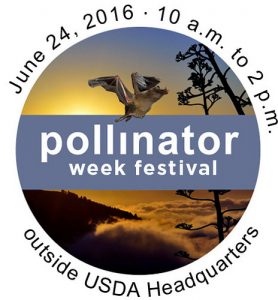24
Jun
USDA Aligns with Chemical Industry for Pollinator Festival, Disinvites Environmentalists
(Beyond Pesticides, June 24, 2016) The U.S. Department of Agriculture (USDA), during its Pollinator Week Festival at the “People’s Garden” on Friday, has shut out environmental public interest groups that are advocating pesticide restrictions to protect bees. Instead, the agriculture agency is teaming up with other federal agencies and chemical industry groups that advocates say have been tone deaf to beekeepers’ pleas for federal government action. This new controversy emerges in the midst of an escalating pollinator crisis with 44% bee colony losses in the last year.
Advocates, who bring the voice of independent science and point to the dangers of bee-toxic neonicotinoid insecticides as a major contributor to the decline in pollinator populations, have been disinvited to the event.  Meanwhile, the Pollinator Partnership, an organization closely affiliated with the chemical industry (Bayer, Syngenta, BASF, CropLife, have all been previously listed as sponsors) will be in attendance. Groups like Beyond Pesticides, which bridges environmental, consumer and farm interests, have participated for several years in the Festival.
Meanwhile, the Pollinator Partnership, an organization closely affiliated with the chemical industry (Bayer, Syngenta, BASF, CropLife, have all been previously listed as sponsors) will be in attendance. Groups like Beyond Pesticides, which bridges environmental, consumer and farm interests, have participated for several years in the Festival.
“The foundation for a constructive dialogue between federal agencies and the public regarding the decline of our critical pollinator populations rests upon the free exchange of information and viewpoints,” said Jay Feldman, executive director of Beyond Pesticides. “We are disappointed that USDA has decided to rescind the offer to participate in the Pollinator Week Festival.”
Last month, the U.S. Government Accountability Office (GAO) reported that USDA and the U.S. Environmental Protection Agency (EPA) are falling short in their efforts to protect honey bees and other wild pollinators from catastrophic declines. According to the report, USDA has not begun to coordinate with other agencies to develop a plan for monitoring wild, native bees because they were focused on other priorities, although charged to do so by the White House Pollinator Task Force. USDA was also chastised by GAO for its inability to evaluate its conservation programs. Although the agency has dedicated millions of dollars to conservation programs, USDA does not have the internal expertise to evaluate the effectiveness of its methods, according to GAO.
Last spring, the White House released its much awaited plan for protecting American pollinators, which identifies key threats, but falls short of recommendations submitted by Beyond Pesticides, beekeepers, and others who stress that pollinator protection begins with strong regulatory action and suspension of bee-toxic pesticides. The Pollinator Health Task Force, established by President Obama in June 2014, brought together most federal agencies to “reverse pollinator losses and help restore populations to healthy levels,” and involved developing a National Pollinator Health Strategy and a Pollinator Research Action Plan. On Wednesday, the White House released its Pollinator Partnership Action Plan (PPAP), which is being criticized as falling short of meaningful action for pollinators, calling for very little protections from pesticides.
Beyond Pesticides and its allies have called for suspensions on neonicotinoid pesticides, particularly the most widely used and toxic: imidacloprid, clothianidin and thiamethoxam. These pesticides are used in a variety of home and garden products, and most commonly in corn and soybean seed coatings, where they remain in plant tissues, including pollen and nectar, for long periods of time. Along with suspensions of registrations, groups have urged EPA to conduct broader reviews on the impact of these systemic pesticides on ecosystems and organisms, including endangered species and biodiversity. Just yesterday, environmental advocates and beekeepers delivered over 4 million signatures to EPA urging an immediate ban on bee-killing pesticides.
All unattributed positions and opinions in this piece are those of Beyond Pesticides.











NO MORE NEONICOID PESTICIDES NOR ANY OTHER LIKE ATRAZINE, WHICH HARMS ALL SPECIES IT GETS INTO. JUST STOP THE QUEST FOR BIG BUCKS OVER NATURE AND US.
June 24th, 2016 at 5:29 pm